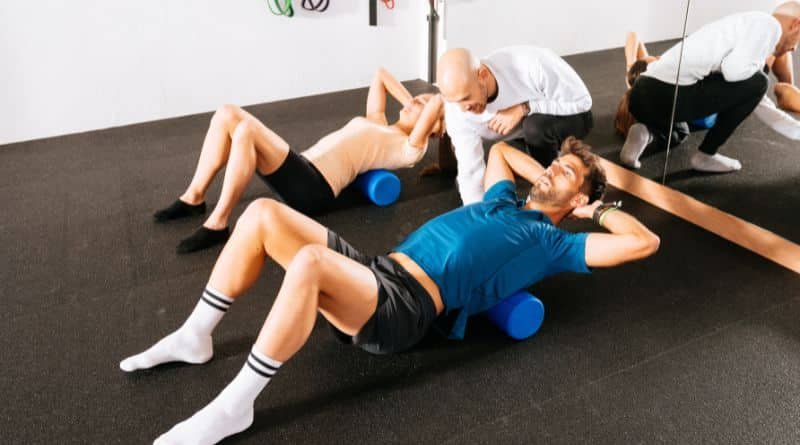Benefits of Foam Rolling Every Day: From Pain Relief to Flexibility
Do you want to know how the benefits of foam rolling every day can change how your body feels and moves? Foam rolling, a self-myofascial release technique, is becoming a staple in the routines of athletes and fitness enthusiasts alike. Physical therapists and trainers primarily utilise foam rolling to alleviate muscle tension and enhance recovery. This practice has permeated mainstream fitness culture due to its simplicity and accessibility.
The benefits of foam rolling every day are manifold, making it a vital practice for individuals engaged in regular physical activity. Foam rolling assists in the maintenance of proper muscle function by breaking down adhesions and knots in muscles, allowing for improved blood circulation and flexibility. Athletes often employ foam rolling to prepare their bodies for workouts, minimizing the risk of injury. Meanwhile, casual fitness participants find that incorporating foam rolling into their routines helps in muscle recovery, alleviating soreness and accelerating the healing process.
Research supports the efficacy of foam rolling, linking it to improved range of motion and reduced muscle stiffness. This practice not only benefits athletes during intensive training periods but also proves to be an advantageous recovery tool for individuals engaging in occasional exercise. The benefits of foam rolling for weight loss also attract attention, primarily because the act of rolling stimulates circulation and encourages the breakdown of fatty tissues. When combined with regular exercise, foam rolling can potentially enhance overall metabolic performance.
As foam rolling continues to gain popularity, understanding its advantages and incorporating it into daily routines is essential for anyone looking to enhance their fitness journey. The potential to reduce recovery time and improve muscle health makes it a valuable addition to both rigorous training protocols and casual workouts.

Key Benefits of Foam Rolling Every Day
Foam rolling has gained popularity among fitness enthusiasts and professionals alike, primarily due to its numerous benefits. Incorporating foam rolling into your daily routine can enhance overall physical performance and improve recovery. Here are some of the key benefits of foam rolling every day:
- Improved Flexibility: Regular foam rolling helps to release tension in muscles and fascia, leading to greater flexibility. This increased range of motion can enhance overall movement quality and make physical activities easier and more enjoyable.
- Enhanced Performance: Foam rolling before a workout can lead to improved muscle activation, allowing for better performance. By preparing the muscles through myofascial release, athletes can experience increased strength, speed, and endurance during their activities.
- Injury Prevention: Implementing a daily foam rolling regimen can aid in preventing injuries by maintaining the health and balance of muscle tissue. It helps identify tight or problematic areas before they develop into more significant issues, allowing for timely intervention.
- Faster Recovery: Foam rolling encourages increased blood flow to the muscles, which is essential for nutrient delivery and waste removal. This process can help reduce muscle soreness post-exercise and speed up recovery times, allowing individuals to return to their routine sooner.
- Stress Relief: Engaging in foam rolling can serve as a form of self-care, providing relaxation and stress relief. The physical act of rolling can promote a sense of well-being and has been shown to reduce muscle tension, making it beneficial for overall mental health.
By understanding and experiencing the benefits of foam rolling every day, individuals can optimize their physical well-being, support their fitness goals, and ultimately lead a healthier lifestyle.
Understanding Muscle RecoveryMuscle recovery is essential to any fitness regimen, as it determines how quickly and effectively the body can repair and rebuild after physical activity. After intense workouts, muscles undergo micro-tears, which must be repaired to help increase strength and endurance. Various factors greatly influence this process, including nutrition, hydration, and recovery practices such as foam rolling.
One significant benefit of foam rolling every day is its ability to enhance blood circulation. Foam rolling promotes increased blood flow to the muscles, which is essential for delivering oxygen and nutrients necessary for recovery. Improved circulation not only aids in faster healing of damaged muscle fibers but also helps in the removal of metabolic waste products that can accumulate during exercise. As a result, the overall recovery process is expedited, allowing individuals to return to their workouts sooner.
Furthermore, foam rolling effectively reduces muscle soreness, often referred to as delayed onset muscle soreness (DOMS). By utilizing a foam roller, individuals can provide self-myofascial release, which helps to alleviate muscle tightness and knots. This technique contributes to the relaxation of muscle tissue and decreases discomfort following strenuous training sessions. Research highlights that regular foam rolling can significantly lessen the severity of soreness, leading to improved performance in subsequent workouts.
Finally, the benefits of foam rolling for weight loss should not be overlooked. While it may not directly result in calorie burning, efficient muscle recovery caused by foam rolling enables individuals to maintain a consistent workout schedule. With reduced soreness and quicker recovery times, individuals are more likely to engage in regular exercise, which ultimately supports weight management goals. Integrating foam rolling into your daily routine can play an essential role in enhancing muscle recovery, maximizing workout performance, and supporting overall fitness objectives.

Foam Rolling Techniques for Beginners
Foam rolling is an effective self-myofascial release technique that can significantly enhance flexibility, reduce muscle soreness, and improve recovery time. For beginners, it is essential to approach foam rolling with proper techniques to maximize the benefits of foam rolling every day. Below are some techniques to get started, alongside suggestions for specific muscle groups to target.
One basic technique involves rolling slowly over the targeted muscle group. Begin by applying gentle pressure. Ideally, you want to roll in a linear fashion along the muscle fibers rather than in a circular motion. For instance, when targeting the quadriceps, place the foam roller under your thighs, and slowly roll from just above the kneecap to the hip flexors. This will effectively alleviate tightness.
Another effective area to focus on is the upper back. Position the foam roller beneath the shoulder blades, leaning back and allowing your body weight to press into the roller. Gently roll from the upper back down toward the mid-back, which helps in relieving tension accumulated from poor posture. Sit on the ground and place the foam roller beneath your calves. Lift your body and roll back and forth, ensuring you cover the entire muscle. The benefits of foam rolling for weight loss can be observed as this practice enhances muscle recovery and may contribute to more effective workouts.
When foam rolling, aim to spend about 30 seconds to a minute on each muscle group. It is vital to breathe deeply and stay relaxed, as this can help reduce discomfort. If any particular spot feels excessively tight, spend additional time there, but avoid excessive pain. Keeping these techniques in mind allows beginners to harness the full range of foam rolling benefits effectively.
The Role of Foam Rolling in Daily Routines
Incorporating foam rolling into daily fitness regimens can significantly enhance physical well-being and performance. Regularly practicing foam rolling, ideally every day, can improve muscle recovery, flexibility, and blood circulation. To effectively integrate this practice into your daily routine, it is essential to consider timing, frequency, and session duration.
A recommended approach is to begin or end your workout with a foam rolling session. This allows for effective warm-up by preparing the muscles before exercise, which can prevent injuries, or aids in muscular recovery post-exercise, helping to alleviate soreness. Aim to dedicate at least 10 to 15 minutes to foam rolling each day, which allows ample time to target all major muscle groups and reap the benefits of foam rolling for weight loss as well. For targeted relief, focus on areas that feel particularly tense or sore, rolling slowly over them and pausing for a few breaths to release any tightness.
The frequency of your foam rolling sessions is equally important. Consistency is key; therefore, making foam rolling a daily habit can unlock its full potential. Start slowly if you are new to foam rolling. It might be beneficial to set aside a specific time each day, such as first thing in the morning or after a workout session, to ensure it becomes a regular part of your routine.
Consider pairing foam rolling with other flexibility or recovery practices such as stretching or yoga. This can enhance muscle relaxation and improve overall mobility. Remember that the benefits of foam rolling every day are cumulative; the more consistently it is practiced, the more pronounced the advantages become.
Foam Rolling for Specific Goals
Foam rolling has gained significant popularity among fitness enthusiasts due to its versatility and myriad benefits. It can be specifically tailored to help individuals achieve various fitness goals, such as weight loss, strength training, and enhanced athletic performance. Understanding how to integrate foam rolling into one’s routine can significantly amplify the results obtained from traditional workouts.
For weight loss foam rolling can aid in improving blood circulation and increasing muscle recovery. It enhances the body’s ability to metabolise fat by promoting the effective breakdown of nutrients. Individuals can maintain a consistent workout schedule by reducing muscle soreness and tightness, which is essential for burning calories and shedding pounds. Regular foam rolling sessions may replenish the body’s energy levels, allowing for longer and more intense workouts, thereby further maximising calorie burn.
In the context of strength training, foam rolling serves as a pre-workout and post-workout tool that can help reduce the risk of injuries. By loosening tight muscles before lifting weights, athletes prepare their bodies for optimal performance, ensuring that their muscles are primed for exertion. Moreover, foam rolling post-strength training aids in recovery by preventing muscle stiffness, thus promoting proper growth cycles within the muscles. This recovery phase is vital as it directly correlates with strength gains over time.
Athletes often incorporate foam rolling as part of their warm-up routine, as it has been shown to improve flexibility and joint range of motion. These enhancements contribute to lower injury rates and improved performance during high-intensity activities. Ultimately, by tailoring foam rolling practices to specific goals, individuals can harness its multitude of benefits effectively, leading to better fitness outcomes and achievements.
Truth Behind Popular Foam Rolling Misconceptions
Foam rolling has garnered significant attention as a key element in fitness regimens, yet various myths persist, often deterring individuals from reaping its full potential. One prevalent misconception is that foam rolling is only beneficial for athletes. In reality, the benefits of foam rolling every day extend to individuals of all fitness levels, promoting enhanced recovery, pain relief, and flexibility irrespective of professional experience.
Another common myth is that foam rolling is merely a form of superficial massage. While foam rolling can resemble massage techniques, its primary function revolves around myofascial release, targeting deeper muscles and connective tissues. This focused application aids in reducing muscle soreness and improving blood circulation, contributing to faster recovery times — factors relevant not just for athletes but anyone looking to maintain an active lifestyle.
Some argue that foam rolling is unnecessary. However, evidence demonstrates the benefits of foam rolling for weight loss indirectly, by increasing range of motion and enhancing workout efficiency. Increased flexibility and muscle elasticity encourage individuals to perform exercises more effectively, potentially leading to greater caloric expenditure during workouts and, consequently, weight loss.
Concerns regarding the safety of foam rolling also underscore many precautions. While improper technique can lead to discomfort, taking a mindful approach to foam rolling minimizes risks. Educating oneself about proper rolling techniques allows users to maximize the benefits effectively without causing injury. In fact, incorporating foam rolling into daily routines can significantly alleviate tension and enhance overall mobility.
To dispel any remaining myths about foam rolling, it is essential to focus on the evidence-based foam rolling benefits that support its practice. A well-rounded understanding of its capabilities empowers more individuals to adopt this beneficial practice into their daily fitness routines, maximising their health outcomes.
Integrating Foam Rolling with Other Recovery Methods
Foam rolling has gained popularity as an essential component of athletic recovery routines. Its effectiveness can be significantly enhanced with other recovery methods such as stretching, massage, and proper hydration. By understanding how foam rolling complements these techniques, individuals can optimise their recovery strategy and experience the extensive benefits of foam rolling daily.
Stretching, for instance, is an essential aspect of any recovery plan. It improves flexibility, promotes muscle relaxation, and enhances overall performance. When foam rolling is added to this regimen, it helps to release muscle tightness and increase blood flow to targeted areas. This increased circulation facilitates the delivery of nutrients and oxygen, further aiding the recovery process. Therefore, combining stretching with foam rolling can intensify the overall benefits of foam rolling for weight loss and muscle recovery, as it aids in reducing soreness and improving mobility.
Massage therapy plays a vital role in recovery. It not only alleviates muscle soreness but also contributes to relaxation and stress management. Foam rolling can act as a self-massage technique, targeting specific muscle groups and offering immediate relief from tension. This method is particularly effective post-workout, as it allows individuals to manage muscle fatigue more efficiently. By utilizing foam rolling in conjunction with professional massages, one can experience profound foam rolling benefits, enhancing muscle recovery while amplifying the effects of each treatment.
The role of hydration cannot be overlooked. Adequate fluid intake is necessary for muscle recovery, ensuring that nutrients are efficiently transported throughout the body. Foam rolling encourages lymphatic drainage and helps in the elimination of toxins, but it should be paired with proper hydration to be truly effective. Ensuring that the body remains hydrated before and after foam rolling sessions can further amplify the benefits derived from both practices.
Integrating foam rolling with stretching, massage, and hydration creates a comprehensive recovery strategy. This holistic approach not only maximizes the benefits of foam rolling every day but also fosters long-term fitness and well-being.
FAQs about Benefits of Foam Rolling Every Day
Foam rolling has gained popularity as an essential part of fitness routines, but many individuals have questions about its practice. This section addresses common queries regarding the benefits of foam rolling every day, including timing, techniques, duration, and safety.
When is the best time to foam roll?
Foam rolling can be beneficial both before and after workouts. Rolling before exercise can serve as an effective warm-up, helping to increase blood flow to muscles and improve flexibility. Conversely, incorporating foam rolling post-exercise aids in recovery, reducing muscle soreness by enhancing circulation and alleviating tension.
What techniques should I use for foam rolling?
There are various techniques to employ while foam rolling. For general muscle recovery, use long, slow strokes on larger muscle groups such as the quads and hamstrings. Targeting specific points of tightness is also effective; simply pause and apply pressure on these areas. It is essential to listen to your body and adjust the intensity as needed.
How long should I foam roll daily?
The duration of foam rolling depends on individual needs and available time. Generally, spending 10 to 20 minutes per day is recommended to reap the foam rolling benefits. Focus on spending about one minute on each muscle group, ensuring you cover all major areas, such as the back, thighs, and calves.
Is foam rolling safe for everyone?
Foam rolling is considered safe for most individuals, but it is pivotal to consult with a healthcare professional if you have any underlying health conditions or injuries. Pregnant individuals or those recovering from surgery should approach foam rolling with caution and guidance.
Is Foam Rolling Good for You?
Foam rolling has gained serious popularity in recent years — and for good reason. It’s often praised as a go-to recovery tool for sore muscles, tight spots, and even injury prevention.
Can Foam Rolling Be Harmful?
Yes — but only if done incorrectly. Foam rolling can cause discomfort, especially if you’re rolling too aggressively or on the wrong areas. Applying excessive pressure directly over joints, bones, or inflamed tissues can lead to bruising or worsen existing injuries.People with conditions like deep vein thrombosis (DVT), severe osteoporosis, or nerve disorders should avoid foam rolling unless cleared by a medical professional. Also, using poor technique or staying on one spot too long can create more tension rather than release it.
Is Foam Rolling Good for You?
Absolutely. When used correctly, foam rolling offers multiple benefits:
- Reduces muscle tightness and soreness
- Improves blood circulation
- Increases flexibility and range of motion
- Helps break up adhesions or “knots” in soft tissue
Foam rolling works through a technique called self-myofascial release. It targets the fascia — the connective tissue surrounding muscles — helping relieve tension and promote recovery after workouts. It’s also a solid addition to warm-ups and cooldowns, making your workouts more effective and less painful the next day.
Can I Use a Foam Roller Every Day?
Yes, you can — as long as you listen to your body. Daily foam rolling is safe for most people and can help maintain muscle elasticity, prevent stiffness, and improve overall mobility. It doesn’t need to be intense or painful. Light, consistent sessions are often more effective than aggressive, occasional ones.If you’re new to foam rolling, start with a softer roller and shorter sessions. Build up gradually to avoid overdoing it.
Why Is Foam Rolling So Effective?
Foam rolling works by relaxing the nervous system and increasing blood flow to muscles. This helps flush out metabolic waste and delivers oxygen-rich nutrients where they’re needed most. It also targets trigger points — small, tight areas within muscle tissue — helping them release and return to normal function. The pressure helps stretch fascia and reduces muscle density, which is why many people feel lighter or looser after rolling. More than just physical, foam rolling can also promote mental relaxation, making it a great addition to your self-care routine.
Understanding these key aspects will enhance your foam rolling experience and allow you to enjoy the comprehensive benefits of foam rolling for weight loss and overall muscle recovery. By integrating foam rolling into your daily routine, you can significantly improve your physical well-being.




